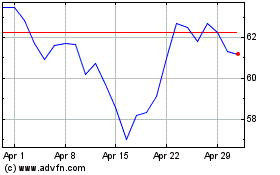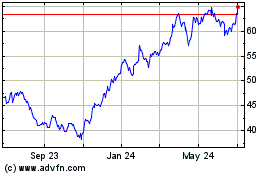United Continental Targets $3.1 Billion in Revenue, Efficiency Gains
June 21 2016 - 8:10AM
Dow Jones News
United Continental Holdings Inc. on Tuesday outlined plans to
boost profitability through a mix of cost and efficiency measures
and securing higher fares from fliers.
The third-largest U.S. airline by traffic aims to lift revenue
and trim expenses by a cumulative $3.1 billion between 2015 and
2018 as part of a broader effort by Chief Executive Oscar Munoz to
reshape a company that some analysts have said requires bigger
reforms to close its profit gap with rivals.
United also said its closely watched average fare metric will be
at the higher end of prior guidance in the second quarter, though
investors will have to wait until the fourth quarter for more
wide-ranging moves that analysts said could include changes to its
route network and long-term financial goals.
Mr. Munoz had set a nine-month time frame for a strategic review
following his appointment as CEO last September, but this slipped
after he suffered a heart attack the following month. A spat with
activist investors this year that concluded with the turnover of
half its board has added to the delay.
United has struggled since its creation. Its 2010 merger
established an airline with one of the best route networks
alongside a host of challenges, including operational problems that
delayed and canceled flights, poor labor relations and higher costs
compared with American Airlines Group Inc. and Delta Air Lines
Inc.
Chicago-based United has improved its on-time flying and
brokered deals with some of its unions, and though the gap between
its profit margins and those at American and Delta halved to around
2.4 percentage points in 2015 compared with the prior year, the
divide has started to widen again, according to analysts at Wolfe
Research LLC.
United aims to secure almost half of the financial
improvements—some $1.5 billion over the three years—by securing
additional revenue and higher fares by better segmenting its
passengers according to their willingness to pay.
Some analysts are skeptical about the goal, given that Delta in
particular has made greater strides to improve its on-time flying
and onboard service, in addition to offering a greater range of
fares such as stripped-down ticket prices aimed at fending off
discount carriers like Spirit Airlines Inc.
While United is trying to improve the transparency of its
turnaround plan, the limited changes announced Tuesday come at a
time when investor sentiment toward airlines remains fragile.
U.S. airlines are this year expected to top 2015's record
profits, but investors are concerned the windfall of lower oil
prices is being dissipated by carriers adding too much capacity and
losing control over pricing.
Falling ticket prices have left a closely watched measure of
per-passenger revenue in decline for more than a year, and
investors continue to move out of airline stocks.
United said its passenger revenue per available seat mile was
expected to be at the top end of prior guidance, forecasting a
decline of 6.5% to 7.5% in the second quarter compared with a year
earlier.
Shares in United are down 24.3% so far this year while American
is off almost 25% and American close to 30%.
Alongside the efforts to boost revenue, United aims to cut $1.3
billion in costs over the next three years, the majority of it from
continuing to shift more flying to larger planes from
less-efficient regional jets.
Write to Doug Cameron at doug.cameron@wsj.com
(END) Dow Jones Newswires
June 21, 2016 07:55 ET (11:55 GMT)
Copyright (c) 2016 Dow Jones & Company, Inc.
Citigroup (NYSE:C)
Historical Stock Chart
From Mar 2024 to Apr 2024

Citigroup (NYSE:C)
Historical Stock Chart
From Apr 2023 to Apr 2024
